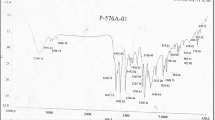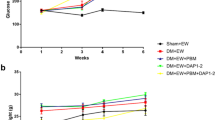Abstract
About twenty percent of diabetic patients develop diabetic wounds and diabetic foot gradually resulting in severe infections and lower limb complications. Antimicrobial peptides (AMPs) are potential candidates exploited for their wound healing properties. Nisin a class I bacteriocin having GRAS (Generally recognized as safe) status has been demonstrated to have wound healing effects. We established a diabetic wound excision model in rats via streptozotocin administration and evaluated the efficacy of nisin in pacing up wound healing in terms of wound closure parameters, collagen content, histopathological and topographical alterations, oxidant and antioxidative environment of wounded tissue, cytokines and growth factors expressions. Significant increase in the levels of hydroxyproline, hexosamine and hexuronic acid upon nisin therapy directly pointed towards the increased collagen content. Significant alterations in wound diameter, levels of IL-1, IL-6, TNF-α and transcriptional levels of VEGF and EGF were observed in treated rats. H&E, picro-sirius red staining and scanning electron micrographic studies of treated skin tissues revealed the restoration of different layers of skin tissue along with increase in collagen content and skin regeneration. Biochemical parameters indicated increase in levels of antioxidants and reduced tlevels of free radicals upon therapy thereby improving the oxidative stress prevailing in wound microenvironment. The present study established nisin as a wound healing promoter in diabetes.



Similar content being viewed by others
Data Availability
The datasets generated during and/or analyzed during the current study are available from the corresponding author on reasonable request.
References
Badr G (2013) Camel whey protein enhances diabetic wound healing in a streptozotocin-induced diabetic mouse model: the critical role of β-Defensin-1,-2 and-3. Lipids Health Dis 12:1–11
Bitter T (1962) A modified uronic acid carbazole reaction. Anal Biochem 4:330–334
Carretero M, Escámez MJ, García M et al (2008) In vitro and in vivo wound healing-promoting activities of human cathelicidin LL-37. J Investig Dermatol 128:223–236
Cohen M, Shilo S, Zuckerman-Levin N et al (2015) Diabetic ketoacidosis in the pediatric population with type 1 diabetes. Major topics in type 1 diabetes. Intech, London, pp 95–119
Elosta A, Ghous T, Ahmed N (2012) Natural products as anti-glycation agents: possible therapeutic potential for diabetic complications. Curr Diabetes Rev 8:92–616
Elson LA, Morgan WTJ (1933) A colorimetric method for the determination of glucosamine and chondrosamine. Biochem J 27:1824–1828
Eming SA, Martin P, Tomic-Canic M (2014) Wound repair and regeneration: mechanisms, signaling, and translation. Sci Transl Med. 6:265sr6
Esposito S, Leone S, Noviello S et al (2008) Foot infections in diabetes (DFIs) in the out-patient setting: an Italian multicentre observational survey. Diabet Med 25:979–984
Falanga V (2005) Wound healing and its impairment in the diabetic foot. Lancet 366:1736–1743
Gautam MK, Purohit V, Agarwal M et al (2014) In vivo healing potential of Aegle marmelos in excision, incision, and dead space wound models. Sci World J 2014:1–9
Gomes D, Santos R, Soares R et al (2020) Pexiganan in combination with nisin to control polymicrobial diabetic foot infections. Antibiotics (basel) 9:128
Gonzalez AC, Costa TF, Andrade ZA et al (2016) Wound healing-a literature review. An Bras Dermatol 91:614–620
Green LC, Wagner DA, Glogowski J et al (1982) Analysis of nitrate, nitrite, and [15N] nitrate in biological fluids. Anal Biochem 126:131–138
Heunis TD, Smith C, Dicks LM (2013) Evaluation of a nisin-eluting nanofiber scaffold to treat Staphylococcus aureus-induced skin infections in mice. Antimicrob Agent Chemother 57:3928–3935
Hirsch T, Spielmann M, Zuhaili B et al (2009) Human beta-defensin-3 promotes wound healing in infected diabetic wounds. J Gene Med 11:220–228
Junqueira LCU, Bignolas G, Brentani RR (1979) Picrosirius staining plus polarization microscopy, a specific method for collagen detection in tissue sections. Histochem J 11:447–455
Kant V, Gopal A, Pathak NN et al (2014) Antioxidant and anti-inflammatory potential of curcumin accelerated the cutaneous wound healing in streptozotocin-induced diabetic rats. Intl Immunopharmacol 20:322–330
Kono Y (1978) Generation of superoxide radical during autoxidation of hydroxylamine and an assay for superoxide dismutase. Arch Biochem Biophys 186:189–195
Lipsky B, Holroyd K, Zasloff M (2009) Topical versus systemic antimicrobial therapy for treating mildly infected diabetic foot ulcers: a randomized, controlled, double-blinded, multicenter trial of pexiganan cream. Clin Infect Dis 47:1537–1545
Liu B, Fu R, Duan Z, Zhu C, Deng J, Fan D (2022) Ionic liquid-based non-releasing antibacterial, anti-inflammatory, high-transparency hydrogel coupled with electrical stimulation for infected diabetic wound healing. Composite B 1(236):109804
Lück H (1965) Catalase. In methods of enzymatic. Analysis 1965:885–894
Luo Y, Song Y (2021) Mechanism of antimicrobial peptides: antimicrobial, anti-inflammatory and antibiofilm activities. Int J Mol Sci 21:11401
Małaczewska J, Kaczorek-Łukowska E (2021) Nisin-A lantibiotic with Immunomodulatory properties: a review. Peptides 137:170479
Malvisi M, Stuknytė M, Magro G et al (2016) Antibacterial activity and immunomodulatory effects on a bovine mammary epithelial cell line exerted by nisin A-producing Lactococcus lactis strains. J Dairy Sci 99:2288–2296
Mbara KC, Rambharose S, Baijnath H, Nlooto M, Owira PM (2022) Antidiabetic effects of Psidium x durbanensis Baijnath & Ramcharun ined (Myrtaceae) leaf extract on streptozotocin induced diabetes in rats. J Ethnopharmacol 14:115542
Mcinnes RL, Cullen BM, Hill KE et al (2014) Contrasting host immuno-inflammatory response to bacterial challenge within venous and diabetic ulcers. Wound Repair Regen 22:58–69
Moron MS, Depierre JW, Mannervik B (1979) Levels of glutathione, glutathione reductase and glutathione S-transferase activities in rat lung and liver. Biochimica Et Biophysica Acta (BBA) 582:67–78
Mouritzen MV, Andrea A, Qvist K et al (2019) Immunomodulatory potential of Nisin A with application in wound healing. Wound Repair Regen 27:650–660
Murthy S, Gautam MK, Goel S et al (2013) Evaluation of in vivo wound healing activity of Bacopa monniera on different wound model in rats. Biomed Res Int 2013:1–9
Oguntibeju J (2019) Type 2 diabetes mellitus, oxidative stress and inflammation: examining the links. Int J Physiol Pathophysiol Pharmacol 11:45–63
Patel S, Srivastava S, Singh MR et al (2019) Mechanistic insight into diabetic wounds: pathogenesis, molecular targets and treatment strategies to pace wound healing. Biomed Pharmacother 112:108615
Pfalzgraff A, Brandenburg K, Weindl G (2018) Antimicrobial peptides and their therapeutic potential for bacterial skin infections and wounds. Front Pharmacol 9:281
Pouget C, Dunyach-Remy C, Pantel A et al (2020) Biofilms in diabetic foot ulcers: significance and clinical relevance. Microorganisms 8:1580
Preet S, Bharati S, Panjeta A et al (2015) Effect of nisin and doxorubicin on DMBA induced skin carcinogenesis–a possible adjunct therapy. Tumor Biol 36:8301–8308
Preet S, Kaur J, Raza K (2021) Nisin loaded carbopol gel against Pseudomonas aeruginosa infected third-degree burns: a therapeutic intervention. Wound Repair Regen 29:711–724
Rahman N, Rahman H, Haris M et al (2017) Wound healing potentials of Thevetia peruviana: antioxidants and inflammatory markers criteria. J Tradit Complement Med 7:519–525
Santos R, Ruza D, Cunha E et al (2019) Diabetic foot infections: application of a nisin biogel to complement the activity of conventional antibiotics and antiseptics against Staphylococcus aureus biofilms. PLoS ONE 14:e0220000
Szkudelski T (2001) The mechanism of alloxan and streptozotocin action in B cells of the rat Pancreas. Physiol Res 50:537–546
Thangarajah H, Chang YD (2009) The molecular basis for impaired hypoxia-induced VEGF expression in diabetic tissues. Proc Natl Acad Sci USA 106:13505–13510
Wills E (1966) Mechanisms of lipid peroxide formation in animal tissues. Biochem J 99:667–676
Xue M, Jackson CJ (2015) Extracellular Matrix Reorganization During Wound Healing and its Impact on Abnormal Scarring. Adv Wound Care 4:119–136
Funding
This work was supported by the Science and Engineering Research Board, Department of Science& Technology, Government of India (EEQ/2017/000540).
Author information
Authors and Affiliations
Contributions
Conception and design of the study: Simran Preet, execution and collection of the data: Shivani Sharma, Data collection, data analysis and original draft: Anshul Panjeta, Execution of staining experiments and data interpretation: Jasleen Kaur, Statistical analysis: Abdulrahman Alshammari, Metab Alharbi, Manuscript review for grammatical errors and interpreted the histology results: Saud Almawash.
Corresponding author
Ethics declarations
Competing interests
The authors declare no competing interests.
Conflict of interest
Simran Preet, Shivani Sharma, Anshul Panjeta, Jasleen Kaur, Abdulrahman Alshammari, Metab Alharbi and Saud Almawash declare that they have no competing interests.
Ethical Approval
All the experimental protocols were approved by The Institutional Animal Ethical Committee of Panjab University, Chandigarh (India) (IAEC/2019/357) and in compliance with the ethics guidelines.
Additional information
Publisher's Note
Springer Nature remains neutral with regard to jurisdictional claims in published maps and institutional affiliations.
Rights and permissions
Springer Nature or its licensor holds exclusive rights to this article under a publishing agreement with the author(s) or other rightsholder(s); author self-archiving of the accepted manuscript version of this article is solely governed by the terms of such publishing agreement and applicable law.
About this article
Cite this article
Preet, S., Sharma, S., Panjeta, A. et al. Accelerated Wound Healing Potential of Nisin in Streptozotocin Induced Diabetes Mellitus in Wistar Rats. Int J Pept Res Ther 28, 147 (2022). https://doi.org/10.1007/s10989-022-10452-8
Accepted:
Published:
DOI: https://doi.org/10.1007/s10989-022-10452-8




